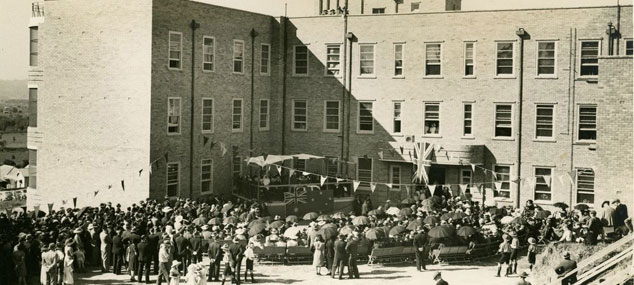
Murwillumbah District Hospital (MDH) has reached a significant milestone, celebrating 120 years of providing healthcare to the local community.
Since its opening in May 1904, hospital staff have cared for generations of patients and seen many changes in the delivery of health services and advancements in patient care.
MDH Executive Office and Director of Nursing Tracey Lea said the hospital had a proud history and a strong connection to the community.
“We are incredibly proud to celebrate this significant milestone,” Ms Lea said.
“It’s a great opportunity to acknowledge the history and achievements and recognise the staff who have contributed to the outstanding care our hospital has provided over the years.”
“The professionalism, compassion and dedication of our staff are what has made Murwillumbah District Hospital such an important and valued part of the community over the past 120 years.”
Ms Lea said the hospital continues to play an important role in providing local healthcare to the community following the recent opening of the new Tweed Valley Hospital (TVH) in Cudgen.
Murwillumbah District Hospital provides key services including emergency department, medical inpatient care, palliative care, chemotherapy, renal dialysis, Midwifery Group Practice, antenatal care and Birth Centre, low complexity day surgery services and a range of outpatient services. The hospital also continues as the dedicated location for rehabilitation services, welcoming patients from right across the Tweed Valley.
Ms Lea thanked staff for their support and dedication to providing excellent patient care, particularly during the hospital’s recent transition to focus on day surgery at the site.
“I want to thank our current and past staff for their commitment to our patients, which is at the heart of everything we do,” Ms Lea said.
“Health services need to change and adapt to be able to respond to the needs of local communities, developments in technology and medical treatments, and changing models of care.
“Our staff have responded to these changes well, and they should be very proud of the high- quality care they deliver every day.
Since 2018, the hospital has received more than $3 million in upgrades and renovations which have delivered a new satellite renal unit, improved the emergency department and medical imaging unit, and provided a new palliative care room.
In the first quarter of 2024, MDH had 5,419 ED attendances, the most ever on record, and an increase of 18.4 per cent compared with the same quarter in 2023.
An official celebration event to mark the 120th anniversary will be held in the coming months.
A brief history of Murwillumbah District Hospital
Information sourced from ‘A Potted History of Murwillumbah District Hospital’ by Millie Higgins.
From a community meeting in 1899, two committees and a Board of Trustees were formed, and an application made to gazette a 15 acre site for the hospital.
A government grant of $500 was received towards the total building cost of $1614, with the community funding the balance.
The Tweed Cottage Hospital, as it was originally named, was officially opened on 20 May 1904 with a three-bed ward for males, a two-bed ward for females, a matron’s room, wardsman’s room, laundry and offices.
A total of 44 patients were treated in its first seven months of operation, however demand grew quickly, with 224 patients treated during 1908, and a new Isolation Block was opened in 1909.
Strong public support for the hospital included many community fundraising activities, such as an annual hospital ball.
In 1910, the hospital was renamed the Tweed District Hospital, and serviced patients from Mullumbimby to southern Gold Coast. The Hospital Auxiliary was formed in 1926.
After continued community advocacy for an extension, the new brick building, designed to accommodate 93 patients, was opened on 27 August 1939. The three-storey building was the largest in the district and included a rarity at the time – an electric elevator.
A feature of the hospital’s history has been the highly dedicated and committed staff, and enormous contributions of volunteers, particularly during the war years when there were medical staff shortages.
The hospital overcame a series of natural disasters over the years, including storms, heavy rains, flooding and a cyclone. On Christmas Day 1953 a severe hailstorm caused significant damage, shattering more than 90 windows and damaging the roof.
On 29 December 1972 the hospital was renamed Murwillumbah District Hospital to avoid confusion with the newly opened Tweed Heads District Hospital in Tweed Heads.
A new wing was opened in 1975 providing emergency, x-ray, pathology, physiotherapy, extra theatres, intensive care, recovery and a central sterilising department.
The new Assessment and Rehabilitation Ward, Urliup, was opened in 1997.